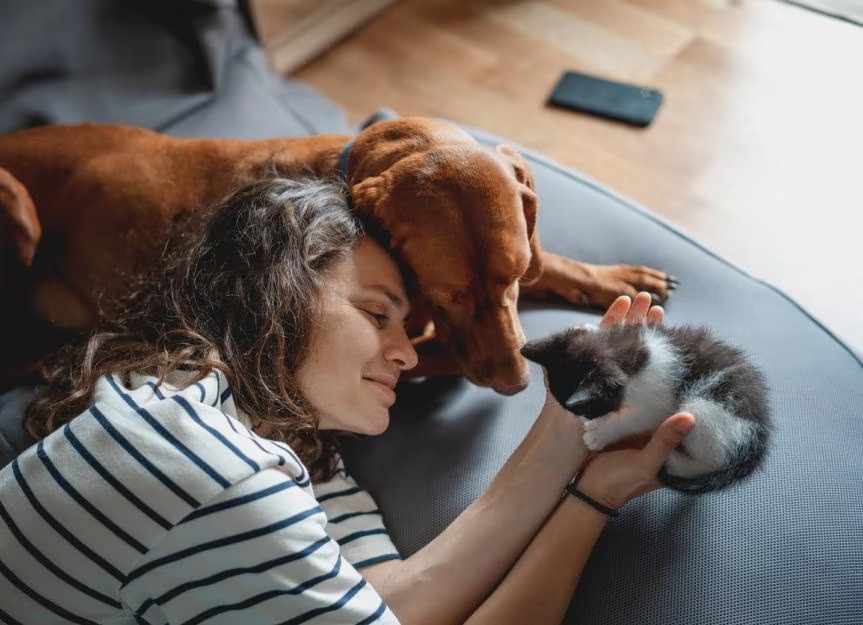Introducing a New Dog to pussycats Through a Pet Gate A Complete Step- by- Step companion
Adding a new canine to your manage that formerly has pussycats requires tolerance . Pussycats and tykes have veritably different social actions and communication styles. Which can occasionally beget stress or conflict if not introduced duly. One proven system to foster a concurrence is introducing a new dog to pussycats through a pet gate .
Why Introduce a New Dog to pussycats through a Pet Gate?
In this comprehensive companion, we’ll explore why using a pet gate is salutary . Training ways, and tips for icing your faves feel safe and comfortable .Introducing a new dog to resident cats through a simple gate has several key benefits:
- Controlled Environment
The pet gate forms a barrier that stops physical contact but still lets you see through it. This setup lowers the meeting’s intensity and helps manage stressful situations.
- Traditional Acclimatization
faves can observe each other’s actions without feeling threatened or overwhelmed. This traditional exposure promotes positive associations over time.
- Minimizes Conflict
By precluding direct contact originally. you minimize the threat of aggression, chasing, or fighting. common issues during new prolusions.
- Assessment of responses
Watching how each beast reacts at the gate shows you their comfort levels and needs. This helps you decide how quickly you can interact with them.
- structure Confidence and Trust
Both faves learn they can observe the other without immediate peril. Helping to make confidence and set the foundation for a harmonious relationship.
According to Beast geste Experts
Associations similar as the RSPCA emphasize the significance of gradational, controlled prolusions. Introducing favorites slowly and carefully can help build a lasting relationship.
Preparing Your Home Before the preface
1. produce Separate safe-deposit box Spaces
Before trying any relations, set up designated areas for your canine and cat
– For the Cat
give high perches, isolated corners, or quiet apartments with waste boxes, food, water, . pussycats frequently feel safest. when they’ve elevated or hidden spots where they can observe and escape if demanded.
– For the Canine insure your canine has a designated resting area and space to relax down from the cat’s home.
Having these safe zones helps your faves retain. A sense of control and security, which is critical during the preface process.
2. Use a Sturdy Pet Gate
Invest in a high- quality pet gate that is
- Altitudinous enough to help jumping over
- Stable and durable
- Made of material that allows clear sightlines( line or acrylic panels)
Set the gate in a doorway or open area that connects the two safe zones. so both faves can see and whiff each other through it.
3. Keep All Pet particulars Ready
- Scent exchange particulars Collect coverlet, toys, or robes that carry each beast’s scent.
- Treats Have delicious treats on hand for positive underpinning.
- Leashes and harnesses Necessary for controlling your canine during supervised relations.
4. Prepare Your faves Mentally and Physically
Insure your cat is relaxed . Avoid listed feedings or conditioning that might beget agitation just before prolusions.
Step- by- Step companion to Introducing Your Canine to Your Cat Using a Pet Gate
Step 1 Scent Exchange
Duration 2- 3 days, or longer if demanded launch by switching coverlet, toys, or cloths between your canine and cat
- Let each precious smell the point from the other’s familiar terrain.
- This helps both creatures get oriented to each other’s scent without direct contact.
cock
During this phase, you can also gently wipe each pet’s face with a cloth . It also allow the other pet to smell it, buttressing recognition of scent.
Step 2 Visual preface Through a Pet Gate
Duration Several sessions over days or weeks, depending on faves’ responses.
1. Position the gate between the cat’s safe zone and the canine’s area.
2. Bring the canine on a leash, icing full control.
3. Allow both faves to observe each other calmly through the gate.
4. Observe their actions Look for curiosity, calmness, or agitation.
Encourage calmness by
- price with treats when petting or observing still.
- Using a calm voice to assure them.
- Avoiding eye contact or unforeseen movements that could be interpreted as hanging .
Important noway force a cat or canine to come closer — let them approach at their own comfort position.
Step 3 Increase Visual Contact and Duration
Over posterior sessions
- Gradationally increase the length of time both faves spend separated by the gate.
- Allow the canine to sit or lie calmly near the gate, buttressing relaxed geste
.
- Instruct family members to remain calm, avoiding loud noises or unforeseen gestures.
Follow- up tips
- Use treats or praise for calm geste .
.
- Observe signs of stress smoothed cognizance, growling, whizzing, or lunging . However, return to shorter, more controlled sessions, If these do.
Step 4 Supervised Direct Interaction
Once both creatures are calm and tolerant of each other through the gate.
1. Remove the gate but keep your canine on a leash .
2. Hold your canine gently but forcefully, allowing brief, supervised hassles.
3. Keep original relations short. Gradationally adding duration as long as both creatures bear calmly.
4. Always be ready to step in or separate if either pet shows aggression or distress.
Make sure the cat has easy escape routes similar as high perches or open doors to retreat into if necessary.
Step 5 Full Interaction and Coexistence
After harmonious positive gests
- Allow unsupervised visits during calm times, but cover their relations originally.
- Continue to award good geste
.
- give separate coffers( food coliseums, waste box, toys) to reduce territorial conflicts.
- Be patient — some faves may take weeks or indeed months to completely accept each other.
Training ways to Support a Successful preface
Desensitization and Counter-Conditioning
- If your canine displays inordinate excitement or preoccupation with the cat. You can gradationally desensitize this test .
.
- Start with the canine at a distance. Satisfying calmness and ignoring over-excited responses.
sluggishly drop the distance as the canine remains calm.
Positive underpinning
Norway discipline either pet for negative response. Rather, calmly deflect or remove them from the situation.
Leash Training
Keep your canine on a leash during original supervised relations. Practice commands similar as “ sit, ” “ stay, ” or “ leave it ” to help manage reactivity.
icing Your Cat’s Comfort During the preface
- give high edge points — shelves, cat trees, or window perches so your cat can observe from over.
- Maintain routine — feeding and playtime should remain harmonious to help anxiety.
- Admire their boundaries — if your cat wants to keep their distance, don’t force relations.
fresh Tips
- noway discipline a cat for hissing or swatting; these are natural defense actions.
- Avoid loud noises or unforeseen movements that could escalate pressure.
- Be attentive to signs of stress or fear and decelerate down the preface timeline if demanded.
Monitoring Progress and Making adaptations
Every pet is unique, and some may bear further time to acclimate
- Watch for signs of stress , similar as caching, avoiding the other pet, or aggression.
- Regularly estimate the situation. If progress booths or conflicts arise, return to earlier stages.
- If conflicts persist or escalate. Consider consulting a professional beast behaviorist for acclimatized advice.
Final studies and tolerance Is crucial
Introducing a new canine to pussycats through a precious gate is a gentle. Effective way to foster peaceful concurrence. The process requires tolerance, thickness, and careful observation. ut yields satisfying results in a harmonious multi-pet ménage.
Flash back
- Admire each pet’s comfort situations.
- Celebrate small successes along the way.
With time and proper operation . Your canine and pussycats can make a positive relationship. And enjoy a happy life together.
Conclusion
In conclusion, bringing a new dog to your cats through a nice gate is a gentle way to help them adjust. This system encourages a gradational adaption and promotes a peaceful concurrence.Tolerance, careful observation, and positive underpinning are crucial to success. By esteeming your faves ‘ comfort, you can produce a happy home.
This way, both dogs and cats will feel safe and loved. Remember, every pet is unique. Adjust the process as needed and celebrate progress along the way.




